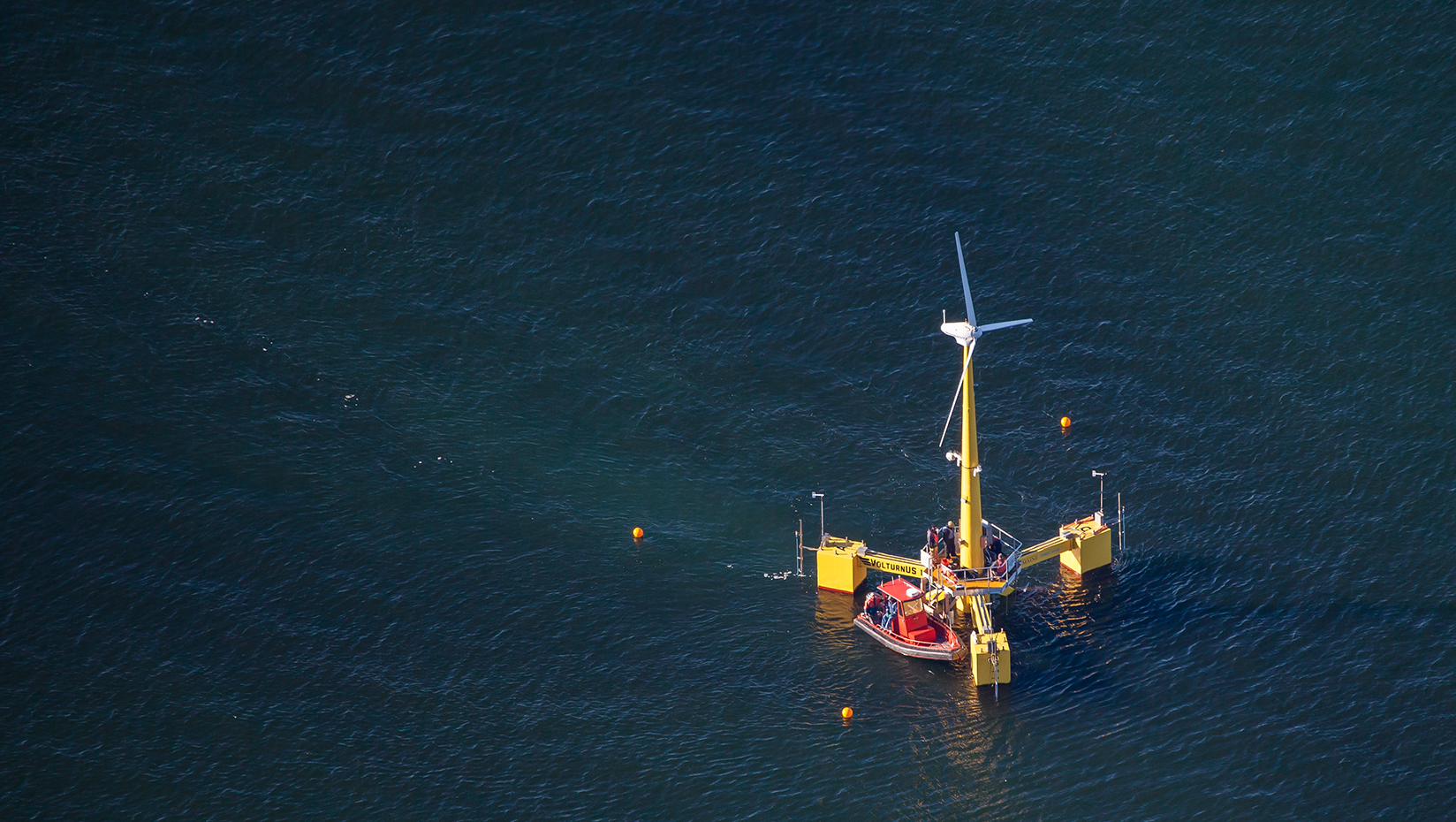
Maine offshore wind project moves to top tier of national demonstration program
Editor’s note: Story updated 5 p.m., May 27.
In a news release this morning, U.S. Senators Susan Collins and Angus King announced that Maine’s New England Aqua Ventus I floating offshore wind demonstration project, designed by a University of Maine-led consortium, has been selected by the U.S. Department of Energy (DOE) to participate in the Offshore Wind Advanced Technology Demonstration program.
New England Aqua Ventus I will now be one of up to three leading projects that are each eligible for up to $39.9 million in additional funding over three years for the construction phase of the demonstration program.
“Today’s decision by the Department of Energy puts Maine firmly on the map of America’s emerging offshore wind industry,” Collins and King said in a joint statement. “With the project’s innovative and cutting-edge floating design, the University of Maine has once again catapulted our state to the forefront of clean energy innovation through advanced technologies that could harness and deploy the vast wind resources off our nation’s coast. This decision is outstanding news for Maine and a testament to the unmatched hard work and ingenuity of the University of Maine and the numerous Aqua Ventus partners. We applaud them for their efforts and will continue to support them as they strive to lead our state and nation into a brighter, cleaner energy future.”
“This is an historic opportunity for Maine and New England, and a real tribute to the vision and dedication of the University of Maine researchers and the consortium partners,” said UMaine President Susan J. Hunter. “With New England Aqua Ventus on the front line of the offshore wind industry in the United States, Maine has the potential to be a leader in renewable energy.
“We’re extremely proud of the floating platform technology developed at the University of Maine Advanced Structures and Composites Center that has been recognized for its innovation by the Department of Energy,” Hunter said. “The level of research and development by UMaine researchers, students and partners that helped make the New England Aqua Ventus project a reality demonstrates the distinction of a public research university — and the difference it can make in its state, region and beyond.”
Today’s announcement is a “game changer for floating offshore wind in the U.S.,” said Dr. Habib Dagher, P.E., executive director of the UMaine Advanced Structures and Composites Center that has led the effort.
“We appreciate the DOE’s vote of confidence in the VolturnUS floating concrete technology. With 12 independent cost estimates from around the U.S. and the world, the VolturnUS floating hull technology has been found to significantly reduce costs compared to existing floating systems. The design has also received a complete third-party engineering review. We look forward to successfully building the two-turbines demonstration project, and to helping start a whole new clean energy industry,” Dagher said.
In May 2014, the DOE announced that the New England Aqua Ventus project had been selected as an alternate for the Offshore Wind Advanced Technology Demonstration Program and was awarded $3 million for continued design and engineering development.
In November 2015, DOE informed Collins and King that it would provide an additional $3.7 million to UMaine, under a contract that will soon be finalized, to continue the development tasks. The award brought total funding for the New England Aqua Ventus project on par with the previously selected demonstration projects that were awarded $6.7 million each.
In April 2016, the New England Aqua Ventus I project was reviewed by DOE to be eligible for $39.9 million toward construction of the demonstration project. Over 70 reports were submitted to the DOE.
That review lead to the decision announced today to upgrade the UMaine project.
The company formed to build the commercial-sized demonstration project is Maine Aqua Ventus I GP, LLC. Initially assembled by UMaine, this global consortium has formed a collaborative leadership team to develop, construct and operate this offshore wind project. It is expected that more than 25 other organizations will contribute to project success.
About UMaine’s Advanced Structures and Composites Center:
Since its establishment by the National Science Foundation in 1996, the Advanced Structures and Composites Center has employed and trained more than 2,000 UMaine students. These students were paid to work on award-winning R&D projects funded by more than 500 Maine-based, national and international companies that partner with the center. The center is housed on campus in a 100,000-square-foot laboratory facility valued at more than $110 million. Research at the center has resulted in 42 issued and pending patents, more than 500 published technical papers and the creation of 14 Maine spin-off companies through licensing agreements of its inventions, patents or trade secrets. For more information about the center, visit their website.
About Maine Aqua Ventus
Maine Aqua Ventus I, GP LLC is a partnership of Emera Inc., Cianbro Corporation and Maine Prime Technologies, LLC, a spin-off company representing the University of Maine, which formed a collaborative leadership team to develop, construct and operate the project. Over 25 other organizations complete this innovative consortium. The goal is promising and rewarding: Maine Aqua Ventus I would create jobs and provide renewable energy now and into the future. For more information about Maine Aqua Ventus, visit their website.
Jennifer O’Leary, 207.515.3341; olearyj@maine.edu
